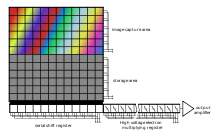User:S Osseir/sandbox
Electron-multiplying CCD[edit]


An electron-multiplying CCD (EMCCD, also known as an L3Vision CCD, L3CCD or Impactron CCD) is a charge-coupled device in which a gain register is placed between the shift register and the output amplifier. The gain register is split up into a large number of stages. In each stage, the electrons are multiplied by impact ionization in a similar way to an avalanche diode. The gain probability at every stage of the register is small (P < 2%), but as the number of elements is large (N > 500), the overall gain can be very high (), with single input electrons giving many thousands of output electrons. Reading a signal from a CCD gives a noise background, typically a few electrons. In an EMCCD, this noise is superimposed on many thousands of electrons rather than a single electron; the devices' primary advantage is thus their negligible readout noise.
EMCCDs show a similar sensitivity to Intensified CCDs (ICCDs). However, as with ICCDs, the gain that is applied in the gain register is stochastic and the exact gain that has been applied to a pixel's charge is impossible to know. At high gains (> 30), this uncertainty has the same effect on the signal-to-noise ratio (SNR) as halving the quantum efficiency (QE) with respect to operation with a gain of unity. However, at very low light levels (where the quantum efficiency is most important), it can be assumed that a pixel either contains an electron — or not. This removes the noise associated with the stochastic multiplication at the risk of counting multiple electrons in the same pixel as a single electron. To avoid multiple counts in one pixel due to coincident photons in this mode of operation, high frame rates are primordial. The dispersion in the gain is shown in the graph on the right. For multiplication registers with many elements and large gains it is well modelled by the equation:
if
where P is the probability of getting n output electrons given m input electrons and a total mean multiplication register gain of g.
Because of the lower costs and better resolution, EMCCDs are capable of replacing ICCDs in many applications. ICCDs still have the advantage that they can be gated very fast and thus are useful in applications like range-gated imaging. EMCCD cameras indispensably need a cooling system — using either thermoelectric cooling or liquid nitrogen — to cool the chip down to temperatures in the range of -65°C to -95°C. This cooling system unfortunately adds additional costs to the EMCCD imaging system and may yield condensation problems in the application. However, high-end EMCCD cameras are equipped with a permanent hermetic vacuum system confining the chip to avoid condensation issues.
The low-light capabilities of EMCCDs primarily find use in astronomy and biomedical research, among other fields. In particular, their low noise at high readout speeds makes them very useful for a variety of astronomical applications involving low light sources and transient events such as lucky imaging of faint stars, high speed photon counting photometry, Fabry-Pérot spectroscopy and high-resolution spectroscopy. More recently, these types of CCDs have broken into the field of biomedical research in low-light applications including small animal imaging, single-molecule imaging, Raman spectroscopy, super resolution microscopy as well as a wide variety of modern fluorescence microscopy techniques thanks to greater SNR in low-light conditions in comparison with traditional CCDs and ICCDs.
In terms of noise, commercial EMCCD cameras typically have clock-induced charge (CIC) and dark current (dependent on the extent of cooling) that together lead to an effective readout noise ranging from 0.01 to 1 electrons per pixel read. However, recent improvements in EMCCD technology have led to a new generation of cameras capable of producing significantly less CIC, higher charge transfer efficiency and an EM gain 5 times higher than what was previously available.[1] These advances in low-light detection lead to an effective total background noise of 0.001 electrons per pixel read, a noise floor unmatched by any other low-light imaging device.[2]
References[edit]
- ^ As specified in Nüvü Caméras' EM N2 camera specsheet.
- ^
Daigle, Olivier; Djazovski, Oleg; Laurin, Denis; Doyon, René; Artigau, Étienne (July 2012). "Characterization results of EMCCDs for extreme low light imaging" (PDF).
{{cite journal}}: Cite journal requires|journal=(help)




